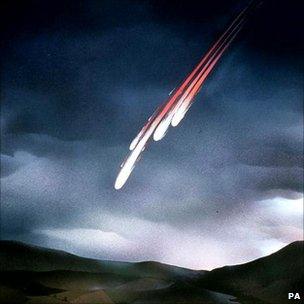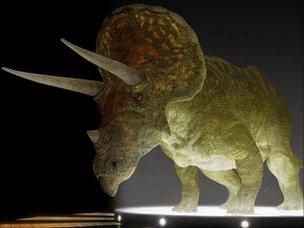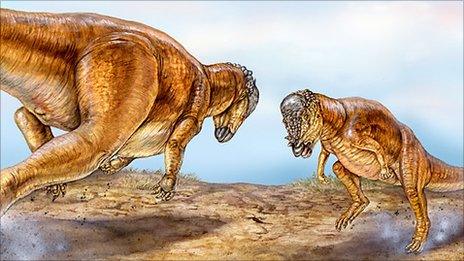Closing the 'three metre gap'
- Published
- comments

Some believe dinosaurs were already in trouble before a catastrophic space impact
Did the dinosaurs go out with a bang or a whimper?
The question is one of the most hotly contested in palaeontology and revolves around an apparent gap in the fossil record immediately prior to the K-T boundary - the distinct layer of geological sediments separating the Cretaceous and Tertiary periods, and associated with a massive asteroid impact and global extinction event.
Rocks laid down at the time - some 65.5 million years ago - show a thin layer abundant in rare elements like Iridium, spherules and shocked Quartz that could only have come from a meteorite impact.
Since no dinosaur fossils have ever been found in sediments dating from after this point, conventional wisdom has it that the largest creatures ever to roam the earth must have been cut down in their prime - victims of an asteroid impact that sparked firestorms, acid rain and a nuclear winter that blotted out the sun.
But there's a problem. The fossil record also shows an apparent lack of dinosaur fossils in the last few million years leading up to the impact. It's been suggested that this "three metre gap" proves that dinosaurs were either extinct, or well on the way out, long before the catastrophic impact event.
Now scientists working in the Hell's Creek formation in the Montana badlands believe they have resolved the dispute.

The find of a fossilised Triceratops appears to bridge the "three metre gap"
Writing in the Royal Society journal Biology Letters, external they report the discovery of a distinctive brow horn from a Ceratopsian dinosaur (most likely a triceratops) just 13 centimetres below the K-T boundary.
According to the lead author of the paper, Yale University's Tyler Lyson, the discovery proves that "at least some dinosaurs were doing pretty well right up to the impact event 65 and a half million years ago, and that dinosaurs did not go extinct prior to the impact".
Gaps in the fossil record - which is patchy at best - are nothing new. Another, covering tens of millions of years, is clearly evident in the Hell's Creek formations some 60 meters below the K-T boundary.
But because similar dinosaur fossils are found both above and below this ancient gap it is assumed the absence of fossils has more to do with geological processes, or even simply blind prospecting luck, than any extinction event and subsequent miraculous reintroduction.
The 3 metre gap prior to the K-T boundary is unique because dinosaur fossils never reappear in the geological record. Speaking on the programme this morning the Natural History Museum's Dr Paul Barrett said the discovery was strong evidence for the catastrophic theory of dinosaur extinction in north America, but not conclusive globally.
"It shows that in this part of the world dinosaurs were still viable and still roaming around at the time the meteorite hit. But what it doesn't tell us is what was going on in the rest of the world, and it could be that in other parts of the world dinosaurs were dying out at different rates and for different reasons because of other things going on at the time".
Just as one swallow doesn't make a summer, it seems, one triceratops brow horn doesn't resolve the argument over dinosaur extinction.
- Published1 July 2011

- Published15 June 2011

- Published27 August 2010
- Published6 October 2010